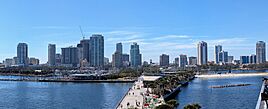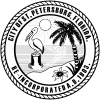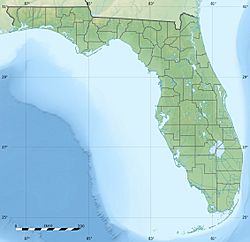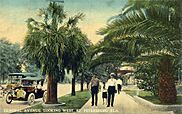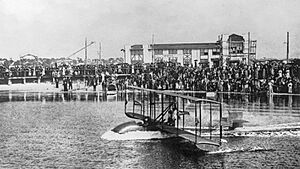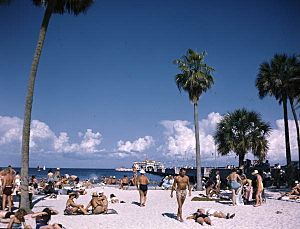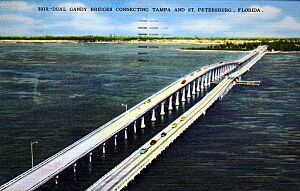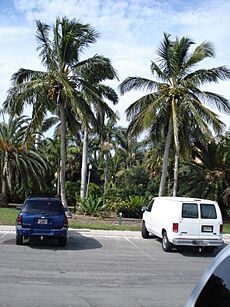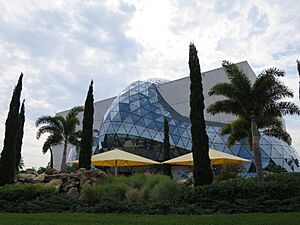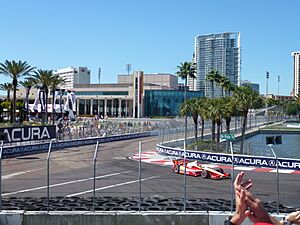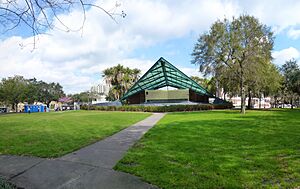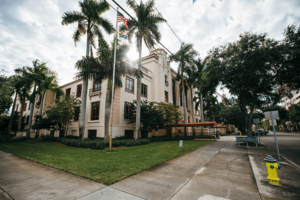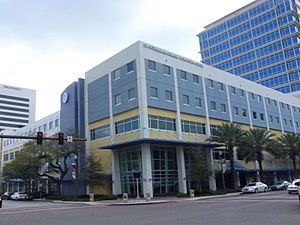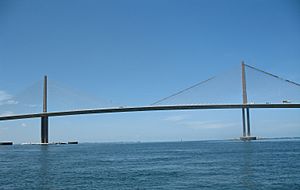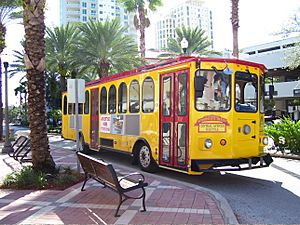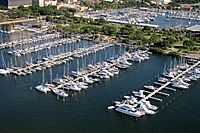St. Petersburg, Florida facts for kids
Quick facts for kids
St. Petersburg
|
|||
|---|---|---|---|
|
Downtown St. Petersburg
|
|||
|
|||
| Nickname(s):
"St. Pete"; "Florida's Sunshine City"
|
|||
| Motto(s):
"Always in Season"
|
|||
| Country | United States | ||
| State | Florida | ||
| County | Pinellas | ||
| Founded | 1888 | ||
| Incorporated (Town of St. Petersberg) | February 29, 1892 | ||
| Reincorporated (City of St. Petersburg) | June 6, 1903 | ||
| Named for | Saint Petersburg, Russia | ||
| Government | |||
| • Type | Strong Mayor-Commission | ||
| Area | |||
| • City | 135.49 sq mi (350.93 km2) | ||
| • Land | 61.87 sq mi (160.24 km2) | ||
| • Water | 73.63 sq mi (190.69 km2) | ||
| Elevation | 44 ft (13.4 m) | ||
| Population
(2020)
|
|||
| • City | 258,308 | ||
| • Estimate
(2022)
|
261,256 | ||
| • Rank | 88th | ||
| • Density | 4,175.08/sq mi (1,612.01/km2) | ||
| • Urban | 2,441,770 (17th) | ||
| • Metro | 2,870,569 (18th) | ||
| Time zone | UTC−05:00 (Eastern (EST)) | ||
| • Summer (DST) | UTC−04:00 (EDT) | ||
| ZIP Codes |
33701-33716, 33729-33734, 33736, 33738, 33740-33743, 33747, 33784
|
||
| Area code(s) | 727 | ||
| FIPS code | 12-63000 | ||
| GNIS feature ID | 290375 | ||
St. Petersburg is a vibrant city in Pinellas County, Florida, United States. It's often called "St. Pete" by locals. In 2020, about 258,308 people lived here. This makes it the fifth-largest city in Florida. It's also the second-biggest city in the Tampa Bay area. This larger area has about 3.29 million people.
St. Petersburg is on a peninsula between Tampa Bay and the Gulf of Mexico. It's known as "The Sunshine City" because it gets about 361 sunny days each year. It even holds a Guinness World Record for 768 days of sunshine in a row! The average water temperature in the Gulf is around 76°F (24°C). Because of its great weather, St. Pete has always been a popular place to visit.
Contents
- Discover St. Petersburg, Florida
- A Look at St. Pete's Past
- St. Pete's Geography and Layout
- Who Lives in St. Pete?
- St. Pete's Economy
- Exciting Events in St. Pete
- Tourism and Fun Things to Do
- Sports in St. Pete
- How St. Pete is Governed
- Art and Culture in St. Pete
- Education in St. Pete
- Media in St. Pete
- Getting Around St. Pete
- International Connections
- Images for kids
- See also
Discover St. Petersburg, Florida
A Look at St. Pete's Past
Early Beginnings
When Spanish explorers first arrived, they met the Safety Harbor culture people. These people built large mounds. The Pánfilo de Narváez expedition landed here in 1528. This was one of the first trips into North America.
How St. Pete Got Its Name
The city was started by John C. Williams and Peter Demens in 1888. They flipped a coin to name the city. Demens won and named it after Saint Petersburg, Russia, his hometown. Williams named the first hotel after his hometown, Detroit. The Detroit Hotel is still downtown today.
The first big newspaper, the St. Petersburg Times, started in 1884. The city got its first electricity in 1897. A large fish business began in 1899, shipping over 1,000 pounds of fish daily.
Growing into a City
St. Petersburg officially became a city in 1903. The waterfront was made deeper for bigger ships. The city's population grew quickly. In 1904, the first trolley service started.
In 1914, Al Lang helped bring baseball spring training to the city. This made St. Petersburg a popular spot for baseball fans. Lang later became mayor and helped the city's population grow a lot.
The first scheduled commercial airline flight happened here in 1914. An airplane flew across Tampa Bay from St. Petersburg to Tampa. The pilot was Tony Jannus, flying a Benoist XIV flying boat.
The city's first library opened in 1915. It's still open today as the Mirror Lake Library.
The Roaring Twenties and Beyond
Tourism boomed in the 1920s. Many visitors came by car, yacht, and train. The Gandy Bridge opened in 1924, making it easier to reach Tampa. The city's buildings started to have a Mediterranean style. The Million Dollar Pier opened in 1926, offering fishing and fun.
The St. Petersburg flag was created in 1927. It has colors that show the city's sunshine, water, and land. A pelican on the flag became a symbol for helping birds in winter.
Tourism slowed during the Great Depression. But the city recovered with help from government projects. During World War II, St. Petersburg became a training base for troops. Many soldiers returned to live or visit after the war.
In the 1950s, more people moved to St. Petersburg. The original Sunshine Skyway Bridge opened in 1954. This bridge connected St. Petersburg to Manatee County. The city's streetcar lines were removed as more cars arrived.
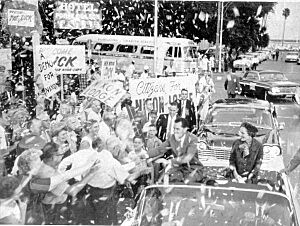
The Howard Frankland Bridge opened in 1960. This created another link between St. Petersburg and Tampa. The city also got its first stadium, the Bayfront Center. A new marina and the Museum of Fine Arts were built. St. Petersburg also has one of the world's largest systems for reusing water.
In 1984, a flying replica of the Benoist XIV flying boat was built. It's now at the St. Petersburg Museum of History.
Modern Times
The idea for a Major League Baseball team in Tampa Bay started in the 1970s. A stadium was planned in 1983. Construction began in 1986. This meant tearing down the Gas Plant neighborhood. The stadium opened in 1990. In 1995, St. Petersburg got a baseball team. The stadium was renamed Tropicana Field in 1996. The Tampa Bay Devil Rays (now Rays) played their first game in 1998.
Highways like I-275 were expanded in the 1970s. The city's population grew a lot through the 1970s. After a period of slower growth, more people have been moving to downtown St. Petersburg.
St. Pete's Geography and Layout
Where is St. Pete?
St. Petersburg covers about 135 square miles (356 square kilometers). About 62 square miles (160 square kilometers) is land, and 73 square miles (196 square kilometers) is water. It's surrounded by three parts of Tampa Bay.
Downtown St. Petersburg
Downtown St. Petersburg is the city's main business area. It has tall office and apartment buildings. The Tampa Bay Times newspaper is based here.
Downtown is home to many cultural places. These include the Mahaffey Theater, Morean Arts Center, and many art galleries. You can also find the Coliseum and Palladium Theatre.
Several famous museums are downtown. These include the Chihuly Collection, the Museum of Fine Arts, and the Salvador Dalí Museum. The St. Petersburg Museum of History and Florida Holocaust Museum are also here. The city hosts many outdoor festivals.
The St. Petersburg Pier stretches half a mile into the bay. It's a big attraction with lots of activities. The new Pier District opened in July 2020. It has green spaces, a marketplace, a playground, and public art.
University of South Florida St. Petersburg and a branch of St. Petersburg College are downtown. The area has many parks, often by the water. Straub Park is nearly half a mile long and is by the waterfront. St. Petersburg ranks high for its public parks. The Vinoy Park Hotel is a historic hotel by Vinoy Park. This park hosts music festivals.
Downtown has many restaurants and places for nightlife. The city council extended bar hours in 2010.
Tropicana Field, home of the Major League Baseball's Tampa Bay Rays, is in western downtown. The stadium is planned to be replaced by 2027. The area around it will also be redeveloped.

St. Petersburg has the third-largest public waterfront park system in North America. It stretches for 7 miles (11 km). People use it all year for events and festivals. Early city leaders decided to keep the waterfront for parks.
St. Petersburg is also a popular spot for kiteboarding. The St. Petersburg Shuffleboard Club opened in 1924. It was once the world's largest.
The Northshore Aquatic Complex is a public pool downtown. It has a large pool and a training pool.
City Views
St. Pete's Neighborhoods
St. Petersburg has over 100 neighborhoods. Many historic areas are near the bay. Downtown has skyscrapers, art galleries, and museums. It's also a hub for new businesses.
North of downtown are the Historic Old Northeast and Snell Isle. These areas have historic homes and parks. Old Northeast has shops and beaches. Snell Isle was developed with fancy properties in the 1900s. The far north is the Gateway area. It has major employers and new buildings.
Central St. Petersburg includes the Grand Central District and Historic Kenwood. These areas are known for cafes, art galleries, and Craftsman style buildings.
South of downtown is Historic Roser Park. It has historic homes and museums.
St. Pete's Climate
St. Petersburg has a warm, humid climate. It has a rainy season from June to September. Tropical plants like coconut palms grow here. The Gizella Kopsick Palm Arboretum has over 500 palms. St. Petersburg is sometimes affected by tropical storms and hurricanes.
Who Lives in St. Pete?
Population Growth
St. Petersburg has grown a lot over the years. In 1890, only 273 people lived here. By 2020, the population was 258,308.
| Historical population | |||
|---|---|---|---|
| Census | Pop. | %± | |
| 1890 | 273 | — | |
| 1900 | 1,575 | 476.9% | |
| 1910 | 4,127 | 162.0% | |
| 1920 | 14,237 | 245.0% | |
| 1930 | 40,425 | 183.9% | |
| 1940 | 60,812 | 50.4% | |
| 1950 | 96,738 | 59.1% | |
| 1960 | 181,298 | 87.4% | |
| 1970 | 216,159 | 19.2% | |
| 1980 | 238,647 | 10.4% | |
| 1990 | 238,629 | 0.0% | |
| 2000 | 248,232 | 4.0% | |
| 2010 | 244,769 | −1.4% | |
| 2020 | 258,308 | 5.5% | |
| 2024 (est.) | 267,102 | 9.1% | |
| U.S. Decennial Census | |||
A Diverse Community
St. Petersburg is home to people from many backgrounds. In 2020, about 61.86% of residents were White. About 20.65% were Black or African American. Asian residents made up 3.46%. People of Hispanic or Latino background made up 9.02%.
Most people in St. Petersburg speak English at home (88.53%). Other languages spoken include Spanish, German, and French.
Beliefs and Faiths
About 35.9% of St. Petersburg residents consider themselves religious. Catholics are the largest group. The Diocese of St. Petersburg oversees many Catholic churches and schools in the area.
St. Pete's Economy
The city's economy is strong in the Gateway area. Healthcare, retail, and professional services are the biggest industries. Many people work in office support, sales, and management.
Top Employers
Here are some of the largest private employers in St. Petersburg:
- Raymond James (Investment)
- Johns Hopkins All Children's Hospital (Healthcare)
- Home Shopping Network (Retail)
- St. Anthony's Hospital (Healthcare)
- Publix Super Markets (Retail)
- Jabil Circuit (Electronics manufacturing)
- Fidelity National Information Services (Financial services)
- Bayfront Medical (Healthcare)
- The Continental Group (Real estate)
- Spectrum (Communications)
City Budget
In 2022, St. Petersburg's operating budget was $711.2 million. The city also has programs to help commercial developments.
Exciting Events in St. Pete
St. Petersburg hosts many events throughout the year.
- The Dr. Martin Luther King Jr. Parade happens in January.
- The Firestone Grand Prix of St. Petersburg is in March. It's an IndyCar Series race held downtown.
- Bluesfest and the Mainsail Art Festival are held in Vinoy Park.
- The Saint Petersburg Art Festival takes place every February.
- St. Anthony's Hospital hosts a downtown triathlon.
- The Green Thumb Festival promotes tree planting.
- St. Pete Pride weekend in June celebrates the LGBT community.
- The 4th of July firework celebration is downtown.
- "St. Pete Pitch Night" in October helps new businesses.
- The annual Ribfest in November features country music.
- The SHINE St. Pete Mural Festival creates amazing murals each year.
- Holiday events like a tree lighting and Santa Parade happen in November and December.
- The city hosts the St. Petersburg Bowl college football game in December.
- First Night St. Petersburg on December 31 celebrates the arts.
- The American Stage in the Park puts on shows at Demens Landing Park.
- The "Second Saturday ArtWalk" is a year-round event.
Tourism and Fun Things to Do
The arts are a big part of tourism here. The Salvador Dalí Museum has the largest collection of Dalí's art outside of Europe. It gets hundreds of thousands of visitors each year. Other art museums include the Museum of Fine Arts and The Chihuly Collection. The Museum of the American Arts and Crafts Movement opened in 2021.
St. Petersburg also has a children's museum (Great Explorations), a Holocaust Museum, and the Dr. Carter G. Woodson African American Museum. The St. Petersburg Museum of History has a replica of the Benoist XIV seaplane.
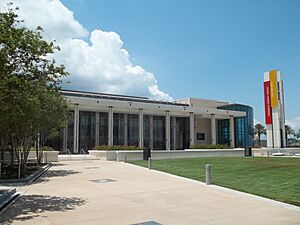
There are many other art galleries and entertainment spots downtown. These include the Mahaffey Theater, American Stage, The Coliseum, and Palladium Theatre.
The new St. Petersburg Pier opened in 2020. It's a popular spot for tourists. The downtown Sundial shopping complex opened in 2014. It has a movie theater, restaurants, and shops.
Every Saturday morning from October to May, downtown hosts a farmers' market.
West of downtown is the 600 Block Arts District. It has unique art and clothing stores. The Grand Central District is known for its art and LGBT community. Haslam's Bookstore, once Florida's largest independent bookstore, was in the Grand Central District.
St. Petersburg has two historic neighborhoods: Roser Park and Grenada Terrace. A bronze statue of Elder Jordan, a former slave who became a successful businessman, stands on 22nd Street.
North of downtown is the Great Explorations Children's Museum. It has interactive exhibits for kids. It's next to Sunken Gardens.
4th Street, from downtown to Gandy Boulevard, has many restaurants. Boyd Hill Nature Park is a 245-acre (1 km²) preserve. You can see many plants and wildlife there.
The main shopping mall is Tyrone Square Mall.
St. Pete in Movies
St. Petersburg has been a filming location for several movies. These include Summer Rental (1985), Cocoon (1985), Ocean's Eleven (2001), Dolphin Tale (2011), and Magic Mike (2012).
Libraries in St. Pete
The St. Petersburg Library System has seven locations:
- President Barack Obama Library
- Childs Park Library
- James Weldon Johnson Community Library
- Mirror Lake Library
- North Community Library
- South Community Library
- West Community Library
The Mirror Lake Library, built in 1915, is one of only two Carnegie libraries still open in Florida.
Sports in St. Pete
| Club | Sport | League | Venue |
|---|---|---|---|
| Tampa Bay Buccaneers | Football | National Football League | Raymond James Stadium, Tampa |
| Tampa Bay Lightning | Ice hockey | National Hockey League | Amalie Arena, Tampa |
| Tampa Bay Rays | Baseball | Major League Baseball | George M. Steinbrenner Field, Tampa |
| Tampa Bay Rowdies | Soccer | United Soccer League | Al Lang Stadium, St. Petersburg |
| Bay Area Pelicans | Rugby | USA Rugby Union | Sawgrass Park, St. Petersburg |
| Grand Prix of St. Petersburg | Auto racing | IndyCar | Downtown Waterfront |
The Tampa-St. Petersburg area has teams in four major professional sports. The Tampa Bay Rays (baseball) and Tampa Bay Rowdies (soccer) play in St. Petersburg. Other teams play in Tampa. All teams represent the whole Tampa Bay area.
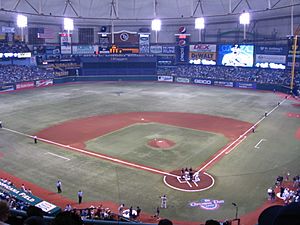
The Rays started playing in 1998. They won the American League Pennant in 2008 and 2020. Tropicana Field is their home stadium. It also hosted the 1999 NCAA Men's Division I Basketball Final Four.
St. Petersburg hosts the Grand Prix of St. Petersburg. This Indy Racing League race uses downtown streets. A road intersecting Turn 10 was renamed Dan Wheldon Way. This was in memory of Dan Wheldon, a racer who won the 2005 race.
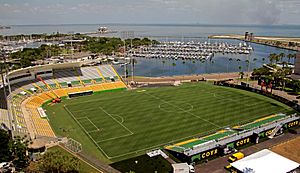
The Tampa Bay Rowdies soccer team moved to Al Lang Stadium in 2011. This stadium is named after Al Lang, a former mayor. The Rowdies hope to join Major League Soccer (MLS) and plan to build a larger stadium.
The Bay Area Pelicans Rugby Football Club has been in St. Petersburg since 1977.
How St. Pete is Governed
St. Petersburg has a strong mayor form of government. The Mayor and City Council members are elected for four-year terms. They can serve two terms in a row. The current mayor is Ken Welch, who took office in January 2022. The City Council has eight members, each representing a different district.
Art and Culture in St. Pete
St. Petersburg is a major art hub in Florida. It has several art districts, museums, galleries, and public artworks. There are over five museums dedicated to fine art. These include the Salvador Dali Museum, the Chihuly Collection, and the Museum of Fine Arts, St. Petersburg.
The city has over 75 art galleries and seven art districts. The Warehouse Arts District and the Deuces Live District are important. The Deuces Live District celebrates African American cultural heritage.
St. Petersburg also has over 600 public art murals. The annual SHINE Mural Festival creates many new murals. Other art festivals include the St. Petersburg Fine Art Festival.
Education in St. Pete
Schools
Public schools in St. Petersburg are managed by Pinellas County Schools. High schools in the city include:
- Gibbs High School
- Lakewood High School
- Northeast High School
- St. Petersburg High School
- St. Petersburg Collegiate High School
Private high schools include:
- Canterbury School of Florida
- St. Petersburg Catholic High School
- Shorecrest Preparatory School
- Admiral Farragut Academy
The non-profit Science Center of Pinellas County teaches thousands of students each year.
Colleges and Universities
St. Petersburg has several colleges. University of South Florida St. Petersburg is a campus of the University of South Florida system. It serves 6,500 students. Eckerd College is a private four-year college. The Poynter Institute is a journalism institute. Stetson Law School is nearby in Gulfport. St. Petersburg College has several campuses in the area.
Media in St. Pete
The main daily newspaper is the Tampa Bay Times. Cable television is provided by Spectrum and Wide Open West. Frontier Communications offers fiber optic service.
Local TV channels include WTSP (CBS) and WTOG (Independent). Spectrum Bay News 9 is a local cable news service. The city also has its own government programming called StPeteTV.
Getting Around St. Pete
Roads and Bridges
St. Petersburg is connected to Tampa by bridges across Tampa Bay. The Sunshine Skyway Bridge connects it to Bradenton in the south. Interstate 275 runs through the city. The Gandy Bridge, opened in 1924, was the first bridge across Tampa Bay.
Airports
Tampa International Airport (TPA) is nearby for many flights. St. Petersburg-Clearwater International Airport (PIE) has flights to smaller cities. Allegiant Air offers year-round service from PIE. Albert Whitted Airport is downtown for smaller planes.
Public Transportation
Public transportation is provided by the Pinellas Suncoast Transit Authority (PSTA). The Looper trolley travels to downtown spots. Bike sharing is also available.
In 2022, PSTA launched the SunRunner. This is a bus rapid transit service connecting downtown St. Petersburg to St. Pete Beach. It was the first of its kind in the Tampa Bay Area.
Trains
CSX Transportation operates a rail line that runs through the area. A former rail line was turned into a popular walking and biking trail called the Pinellas Trail.
Ports and Marinas
The Port of St. Petersburg is a main sea transportation area. There are also marinas like the Municipal Marina. The Cross-Bay ferry travels between St. Pete and downtown Tampa.
International Connections
St. Petersburg is part of the Sister Cities International group.
 Takamatsu, Japan (since 1961)
Takamatsu, Japan (since 1961) Isla Mujeres, Mexico (since 2016)
Isla Mujeres, Mexico (since 2016)
Every year, St. Pete sponsors high school students for a summer exchange with Takamatsu.
St. Petersburg also has "twin cities":
 Saint Petersburg, Russia
Saint Petersburg, Russia Figueres, Spain (since 2011)
Figueres, Spain (since 2011)
Images for kids
See also
 In Spanish: San Petersburgo (Florida) para niños
In Spanish: San Petersburgo (Florida) para niños


